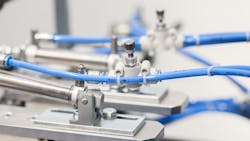From the Editor's Desk: What Industrial Fluid Power Topics Interest You?
Industrial applications are an important customer market for the fluid power industry. Metalworking and machine tools, food processing, packaging machinery, and semiconductors are just some of the industrial applications which rely on fluid power solutions.
Even as automation increases in this sector, and with it the use of alternative solutions such as electric actuators, hydraulic and pneumatic systems remain critical to the operation of many industrial machines.
Given the importance of the industrial machinery sector to the fluid power industry, and the many technological innovations taking place within this space, Power & Motion will be dedicating an entire week of new content, from October 13-17, to topics related to industrial fluid power.
Throughout this 'takeover week' our team is aiming to spotlight technology developments for hydraulics and pneumatics utilized in industrial — also referred to as in-plant — applications, case studies, and more. Our goal is to not only highlight the many fluid power innovations occurring within this space but also the vital role hydraulics and pneumatics continue to play.
Here though is where we need your help. To ensure we're bringing you, Power & Motion's readers, the content you want to see, we need your input on the topics you'd like to see us cover during this takeover week — and in the future related to industrial fluid power.
You can take our brief 1-question survey below to let us know what topics related to industrial fluid power you'd like to see Power & Motion cover.
You can also reach out to me directly at [email protected] to let me know what topics you'd like to learn more about or if you are interested in discussing your own work in the indsutrial space or have an application story to share.
About the Author
Sara Jensen
Executive Editor, Power & Motion
Sara Jensen is executive editor of Power & Motion, directing expanded coverage into the modern fluid power space, as well as mechatronic and smart technologies. She has over 15 years of publishing experience. Prior to Power & Motion she spent 11 years with a trade publication for engineers of heavy-duty equipment, the last 3 of which were as the editor and brand lead. Over the course of her time in the B2B industry, Sara has gained an extensive knowledge of various heavy-duty equipment industries — including construction, agriculture, mining and on-road trucks —along with the systems and market trends which impact them such as fluid power and electronic motion control technologies.
You can follow Sara and Power & Motion via the following social media handles:
X (formerly Twitter): @TechnlgyEditor and @PowerMotionTech
LinkedIn: @SaraJensen and @Power&Motion
Facebook: @PowerMotionTech

Leaders relevant to this article:

